Utah Ants
Ants seem to be rampant in the state of Utah.
Whether you are camping, having a picnic or working in the yard, you are likely to see a colony of ants. According to Utah State University’s Extension System and Utah Plant Pest Diagnostic Laboratory, the 5 most common type of ants found in Utah include carpenter ants, field ants, pavement ants, velvety tree ants and harvester ants. Species of ants vary, and so does the damage they are capable of. In order to fully eradicate a pest problem, you must contact a professional.
That being said, below we’ve included a bit of insight on each of these common types of ants in Utah.
Carpenter Ants
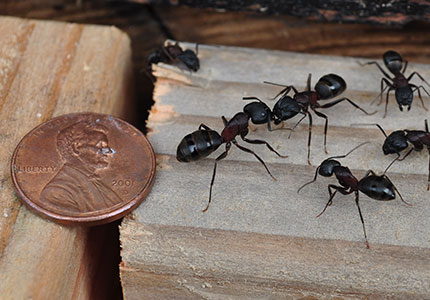
Carpenter ants are known to be one of the largest types of ants, and are also known as giant ants. This type of ant is rampant in Utah. This type of ant can reach up to 1 inch long. Characteristics of this bug also include black or red skin color. The queen ants in this colony also have the ability to grow wings and fly. Carpenter ants feed on any available source of sugar or protein. When outdoors, this ant type will feast on other dead insects, honeydew or sweet flower liquid. If a Carpenter ant is indoors, it will eat pet food, left out syrup, honey, sugar, or jelly. Despite its name, Carpenter ants do not eat wood. That being said, these ants will remove wood from areas in order to create a hole, in which they will nest.
Velvety Tree Ants
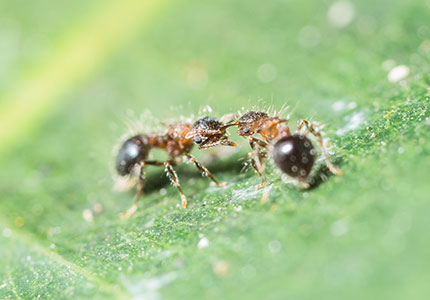
Velvety Tree ants are most commonly found in California, but also frequent the state of Utah. Some characteristics of this ant include an outer shell red-brown in color. Velvety Tree ants get their unique name from the soft, black and hairy underbelly they have. These ants typically measure ¼ of an inch in length.
The Velvety Tree ant lives outdoors primarily, with a diet consisting of honeydew produced by aphids, mealworm bugs and scales that live in surrounding trees. This ant type will also feed on shrubbery and other plants. When Velvety Tree ants make their way indoors, they will nest in wet or rotting wood, inside walls or any moist area. The ant will gnaw at window screens in order to get inside. Velvety Tree ants have the ability to bite, so be careful! The bite is essentially harmless, but will cause mild to moderate pain.
Pavement Ants
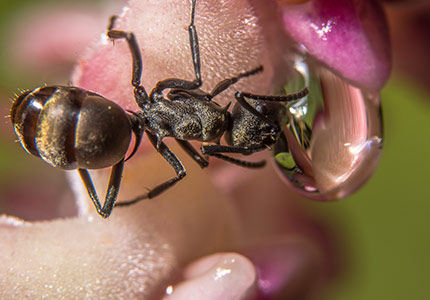
What do Pavement Ants look like? This type of ant can range from light brown to black. Their legs appear lighter in color than the rest of their body. They are about 2 to 3 mm in length, and have vertical lines on their head. Pavement ants also have a 12-segmented antennae. These bugs reside inside cracks on the pavement, patios and sidewalks. Because of this, they will often find their way inside of homes or buildings looking for food. Pavement ants live on a diet consisting of sweet sources, dead insects and protein sources. They will also feast on leftovers or trash around or inside of a building. This type of ant does not bite, but has the ability to sting. Pavement ants are typically non-aggressive, but will attack if they feel threatened.
Harvester Ants (Fire Ants, Red Ants)
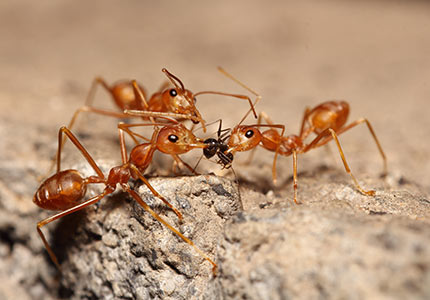
Harvester ants are bright red to dark red, sometimes black, in color. This is why they are often referred to as Fire Ants, or Red Ants. These ants feed on vegetation, mushrooms and plant seeds. This type of ant does prefer to live outside. The Harvester ant is attracted to hot and dry areas. That is a big part of the reason they live in Utah. Because the Harvester ant prefers to bask in the sun, they do lose a lot of their internal water. They have adapted to this by metabolizing the fat from seeds in their diet.
The Red Harvester ants are known to be aggressive. When they feel threatened, stinging is their defense mechanism. Should a Red Harvester ant sting you, it will leave a painful mark. If you suspect that you’ve been stung by this type of ant, clean the infected area with hydrogen peroxide. Applying pressure and ice will help lessen the pain. Keep an eye on the sting spot, as some people have reported allergic reactions to Red Harvester ant stings. Seek medical help if you experience excessive bleeding, swelling or migraine headaches.
Field Ants
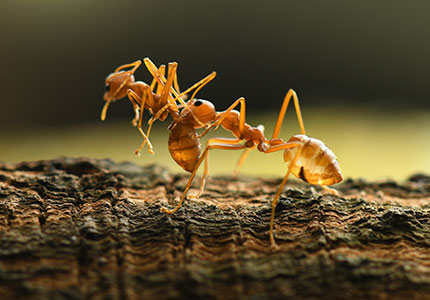
The length ranges from 4 to 8 mm, depending on the type of Field ant you are measuring. Other characteristics of this type of ant include an outer appearance of yellow, red, black or a mixture of these colors. These ants are large in stature, and are also known as giant ants. Many people confuse Field ants with Carpenter ants for this reason. An ideal environment for these ants would be open, such as a grassy lawn or meadow. Field ants do not nest inside of homes or buildings. That being said, this pest will come inside when searching for something to eat. They usually enter structures through cracked windows or poor weather stripping along door frames. Field ants will build mounds and crawl inside as a way to protect the colony from outside elements.
Here is a list of some ways you can prevent an ant infestation:
- Seal off all doors and windows with sufficient weather stripping materials.
- We love pets, NOT pests! If you own any pets, make sure to keep their eating areas clean and dry. Ants often come inside for food, and will feast on kibble and other animal foods.
- Keep a clean kitchen. This is incredibly important if you want to prevent an ant infestation.
- Get rid of any standing water in the home.
Already have an ant infestation? Here are some tips on how to eliminate that problem:
- Locate the area where ants are entering the structure. You can do this by walking around the outside of your home, scanning for ants and where they might be entering.
- Spray the exterior of your home with bug killing product. Not all at-home bug sprays are effective, but you can give it a try.
- Ant traps.
- Call an exterminator. If you think your ant problem is too large to tackle on your own, pest control providers are your best bet in eliminating ants.

